We create professional, goal-orientated and powerful animated explainer videos that entertain, educate and engage!
Don't wanna be here? Send us removal request.
Text

The Best Animated Christmas Adverts of All Time
We love a Christmas advert in Britain. Whenever the latest John Lewis or Marks & Spencer Christmas advert is released it makes news headlines. The public takes to the internet to compare it to adverts of past and rank which advert has been the best tear-jerker so far.
At Squideo, our favourite Christmas ads are the animated variety. We love to see what other animation companies are experimenting with, which pop culture characters are in the public consciousness, and what audiences are responding to. We’re ranking our ten favourite animated Christmas adverts (to date). Let us know if we missed your pick!
10 Best Animated Christmas Adverts
10. It’s a Wonderful Flight | Heathrow Airport 2017
Combining live-action and CGI, the iconic Heathrow Bears sold at Heathrow Airport take centre stage in this advert. On a series of Christmas Eve flights, a family of Heathrow Bears grows over the years in a video which promotes the staff of Heathrow Airport who work throughout the Christmas holiday as well as this classic souvenir.
youtube
09. Paddington & The Christmas Visitor | Marks and Spencer 2017
Released in the same year as Paddington 2, Marks and Spencer took advantage of the film’s publicity by making this special bear the star of their Christmas advert. The video subtly places M&S products throughout, but it is Ben Whishaw who is the star of this advert along with Mark Benton and a cameo from Angela Ripon. M&S rarely hold back on the celebrity guest stars in their adverts, but it is the touching scene at the end of this advert that truly makes it memorable.
youtube
08. A Comfy Carol | DFS 2020
Wallace and Gromit have been popular characters since they first graced the screen in 1989, and DFS must have known they had a safe bet when they approached Aardman Animation to make their Christmas advert. The product placement – a warm and comfortable couch – only appears at the very end of the video, with much of the advert dedicated to Wallace’s typical eccentricities and Gromit’s usual exasperation.
youtube
07. Northern Lights | Coca Cola 1993
The Coca Cola polar bears have been a popular mascot used by the company since 1993, often appearing in their advertising in the run up to Christmas. This simple advert departed from the brand’s usual live-action human-centric videos and used state-of-the-art computer animation. The ad was so popular that even Coca Cola’s competitors Pepsi got in on the action, eventually releasing their own polar bear advert. Who knew bears loved soft drinks so much?
youtube
06. Inner Child | McDonald’s 2020
Made in support of FareShare UK, this 3D animated McDonald’s advert doesn’t rely on characters from famous franchises. Instead it creates its own original characters, a mother and a son whose relationship is strengthened over a McDonald’s happy meal. Animation is cleverly used to show the son’s growing distance, contrasted with his inner child who longs to participate in all the Christmas traditions. Joining McDonald’s existing #ReindeerReady campaign, it ends with them setting out McDonald’s provided carrot sticks in wait of Santa’s arrival.
youtube
05. Get More Out Of Giving | Very 2019
Another yearly campaign, Very’s Get More Out Of Giving promotes community and kindness during the Christmas holidays. In 2019, Very used 3D animation to create a neighbourhood coming together to create a gift for one of the residents. Very has used the same street of houses in previous adverts and takes advantage of the existing character development to advance the story. Using Very branding in the form of a glowing pink present, it is a subtle advert without any product placement that effectively pulls on the heartstrings.
youtube
04. Father Christmas to the Rescue | Barbour 2020
Using the beloved animation of Raymond Briggs’ Father Christmas, this advert was inspired by a real incident which is credited at the end of the video. After the family dog rips an heirloom Barbour jacket, Father Christmas is called upon to mend it. The advert signposts the repair services Barbour offer, rather than promoting buying a new replacement. It’s a sweet story, but the best part is seeing Briggs’ characters brought to life yet again.
youtube
03. Mog’s Christmas Calamity | Sainsbury’s 2015
Prepare for the advert guaranteed to bring tears to Scrooge’s eyes. Narrated by author Judith Kerr, the original creator of Mog who also cameos in the video, this live-action and 3D animation advert was accompanied by a Sainsbury-exclusive book and plush toy with proceeds going to Save the Children. Mog gets up to his usual antics, and the Thomas’ home catches fire – destroying the downstairs living area in a moment which brings the fun calamity to a sobering moment. Quickly the neighbourhood rallies around the family, cleaning up the house and sharing their Christmas. It’s an emotional rollercoaster which instantly became a Christmas advert classic.
youtube
02. The Stepdad | Disney 2021
Part of Disney’s From Our Family to Yours campaign, the company continues its support of Make-A-Wish International through sales of the video’s original song performed by Gregory Porter. The second advert to follow this growing family, the titular stepdad struggles to find his place in the household but fortunately the love he and his step kids share for Disney comes to the rescue. From watching original Disney programming, reading Disney books and building a Disney-inspired gingerbread house, there’s no shortage of product placement in this advert. And yet, despite this, it keeps the characters central and creates a heartwarming story.
youtube
01. The Bear and the Hare | John Lewis 2013
Combining 2D and stop-motion animation, this was the video that started John Lewis’ reign as the Christmas advert titan. Using Lily Allen’s cover of Somewhere Only We Know, the single became a UK number one hit and the video has over 54 million views on YouTube. Every John Lewis advert since is compared to The Bear and the Hare. From its beautifully animated characters to the simplicity of the story, there was no other advert in the running for our number one spot.
youtube
Create Your Own Animated Video
Did your favourite animated Christmas advert make the list? Why not get started on an animated video of your own. Get in touch with us to find out more!
#christmas ads#heathrow bears#paddington bear#m&s#wallace and gromit#dfs#coca cola#coca cola polar bears#mcdonalds#very#raymond briggs#father christmas#barbour#mog#judith kerr#sainsburys#disney#john lewis#john lewis christmas#the bear and the hare#youtube#animation#small business on tumblr#marketing#marketing strategy#Youtube
1 note
·
View note
Text
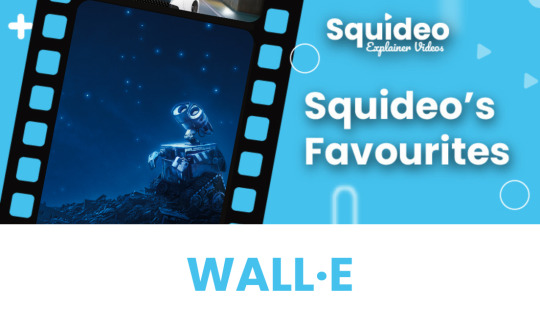
Squideo’s Favourites: WALL·E 🌱
Released in 2008 as Pixar Animation Studio’s ninth feature film, its third since the company was purchased by the Walt Disney Company in 2006, WALL·E had been in the works since the nineties. Created by Andrew Stanton and Pete Docter, this fast classic has become one of Pixar’s standout films. So much so that Disney pushed for an Academy Award Best Picture nomination.
Controversially, this wasn’t accepted by the judges but WALL·E did go on to win their Best Animated Feature prize, and also scooped it up at the BAFTAs, Golden Globes, Hugo Awards, People’s Choice Awards, Saturn Awards, and many more. It even scored two Grammys for Randy Newman and Peter Gabriel’s music performances.
We’re diving into the production behind this animated film, exploring the style and techniques which came together to create this compelling story.
Creating a Story
When Andrew Stanton first came up with the idea for WALL·E, the premise was simple: “what if mankind left Earth and somebody forgot to turn the last robot off?” This was first pitched in 1994 when the young company was thinking about its future films, yet WALL·E wouldn’t start production until 2003 – eventually making it onto screens in 2008.
Stanton continued to develop the idea of a Robinson Crusoe robot with Pete Docter in the nineties, even as both went on to direct other Pixar projects – Finding Nemo (2003) and Monsters, Inc (2001) respectively. There was doubt, however, that this film could be pulled off. Pixar had created anthropomorphised robots before in its first animated short Luxo Jr. (1986). The lamp depicted in this short would become Pixar’s mascot, but was a feature film about a robot something that could be compellingly animated?

What helped to move WALL·E into production was the release of the massively successful Finding Nemo. Like robots, fish weren’t expressive. Like outer space, water was difficult to animate. And yet they pulled it off, releasing what became the highest-grossing animated feature film of all time up to that point and Pixar’s first Academy Award winner. Directed by Stanton, he now had the attention of the company who were eager to hear his next idea.
“WALL-E was a very conscious dive into risk. I knew nobody really wanted to make it. But I also knew nobody could say no to me because Nemo was just so big… we’d been so successful at that point that we could afford the hiccup. If we called it wrong economically or critically, we’d survive it.” Andrew Stanton
The film centred on two robots who only spoke when communicating their names and directives. The majority of WALL·E’s first half is largely free of dialogue, with the exception of live-action recordings from Hello, Dolly! (1969) and Buy n Large’s owner. Many robot characters only converse with chirps and beeps, and the only robot with full lines of dialogue is 2001: A Space Odyssey-inspired villain Auto.
youtube
Key to getting WALL·E into production was the approval of Steve Jobs, who was Pixar’s primary investor and acted as their co-founder and chairman. Jobs split his time at Pixar with Apple where, in 2004, an exciting new product was announced to a select number of people: the development of the first iPhone. The developments at Apple ended up having a profound impact on WALL·E, with the team at Pixar receiving prototype phones before the general public. The film was punctuated throughout with Apple references, using the sound of the Mac boot-up chime when WALL·E finishes charging, and the iPod and iPhone inspiring EVE’s design.
The story is built on themes of environmentalism and global catastrophe, examining consumerism and complacency. One of Pixar and Disney’s most politically themed films, WALL·E attracted conservative criticism but that didn’t stop it from performing at the box office: grossing $532 million worldwide. Receiving widespread acclaim, WALL·E became the second Pixar feature film to be preserved by the National Film Registry and Library of Congress in 2021. In 2022, WALL·E also became Pixar’s first film selected by The Criterion Collection.
Animation Style
While other Pixar films typically generated between 50 and 75,000 storyboards for each production, WALL·E ended up with over 125,000 drawings and 96,000 storyboards. A lot of thought had to go into the character’s design, since their emotions would have to be conveyed physically rather than verbally.
“Robots are a huge challenge, because robots are function-based machines. When you’re drawing them, you can only make up so much stuff that doesn’t actually function, or the person looking at them, even if they’re not engineers themselves, they’re going to notice that that joint wouldn’t actually work. So it became important to look at actual robots. You can only make so much up out of your head.” Jason Dreamer
The team looked at a variety of robots, including those made for bomb disposal. For Jim Reardon, head of story for WALL•E, it was important that they didn’t “draw human-looking robots with arms, legs, heads and eyes, and have them talk. We wanted to take objects that you normally wouldn’t associate with having humanlike characteristics and see what we could get out of them through design and animation.”
To help, Stanton arranged film screenings of classic silent films from the likes of Charlie Chaplin and Buster Keaton to show how silent film actors told stories without reliance on dialogue.
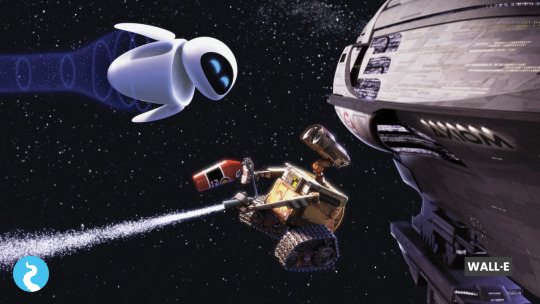
To create the wasteland that WALL·E is left behind in, the animators looked at everything from local dumps to the abandoned city of Chernobyl. For the modern ship Axiom, they looked to Disneyland’s Tomorrowland and cruise ships. To design the human characters, they consulted with physiologist James Hicks to find out the effects of atrophy and prolonged weightlessness while living in space, proving that no detail was too small for the team behind WALL·E.
All of these considerations created a future that seems tangible, and helps to drive the importance of the film’s themes. WALL·E ends on an optimistic note, with Jim Capobianco’s end credits which show the evolution of humanity through different schools of art. For audiences facing the realities of climate change and environmental destruction, this confidence in the power of humanity to fix our world is the right ending. Perhaps explaining why it is one of the few Pixar films to receive no sequel or animated shorts. The story is perfect as it is.
youtube
Get Started With Your Video
Inspired to create a unique animated video of your own? Watch the video below to get a better understanding of how Squideo can help promote your business, then get in touch with us to find out more!
youtube
#wall e#pixar animation studios#disney pixar#pixar#andrew stanton#pete docter#randy newman#peter gabriel#luxo jr#finding nemo#steve jobs#apple#iphone#ipod#criterion collection#jim reardon#jason dreamer#jim capobianco#Youtube
3 notes
·
View notes
Text
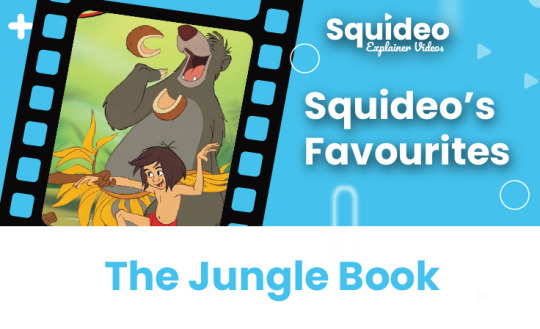
Squideo’s Favourites: The Jungle Book (1967)
The last animated film made under the creative directorship of Walt Disney before his untimely death in 1966, The Jungle Book (1967) marked the end of Disney’s Silver Age. It has become an interesting milestone in the company’s history; reflecting the studio of old while showing the first signs of the company it would become without Walt Disney at its helm.
The Jungle Book has also been resurrected by Disney’s live-action remake series, the first of its modern remakes to adapt a non-Disney Princess story. The 2016 live-action and CGI film made changes to the plot of the 1967 version to correct outdated cultural depictions, but neither can be called faithful adaptations of Rudyard Kipling’s book of the same name. Like the 1967 version, the 2016 remake shows the progression of the Walt Disney Animation Studios and how it continues to innovate while preserving its founding principles.
We’re diving into the production behind this animated film, exploring the style and techniques which came together to create this compelling story.
Creating a Story
The Jungle Book, by British author Rudyard Kipling, was published in 1894. This collection of stories were inspired by Indian folklore and Kipling’s experiences of living and working in India; but Disney’s adaptation of this popular children’s book reads very differently.
Throughout the 1950s and early 1960s, Walt Disney had drifted away from the animation department. He had been focused on Disneyland, the creation of WED Enterprises (later named Imagineering), live-action films and the development of Disney’s television programmes. The underwhelming performance of The Sword in the Stone (1963) compared to the success of One Hundred and One Dalmatians (1961), however, encouraged him to check in on the studio’s next animated feature film: The Jungle Book.
According to Brian Sibley, “what [Walt] found was that the team headed up by Bill Peet had come up with quite a sombre, dark, serious story – much more serious than any films they’d done in animation since the days of Pinocchio.” Peet and Walt Disney disagreed with the direction of the film, which ended in Peet leaving the company and Disney ordering work on The Jungle Book to be restarted.
Most of the original work was scrapped, with the exception of the song The Bare Necessities which was written by Terry Gilkyson (the song was nominated for an Academy Award). When Walt Disney assembled his new animation team, he asked if anyone had read Kipling’s book. They hadn’t, and Walt Disney said “the first thing I want you to do is not to read it."
youtube
He brought in the Sherman Brothers, who were enjoying newfound fame as a result of their work on Mary Poppins (1964). These songwriters were tasked with creating a lighter, family-friendly tone for the film. Meanwhile, the new animation team started production of The Jungle Book in 1965.
Like Disney’s other 1960s features, animators used xerography on the film. Ub Iwerks had adapted the Xerox process, first introduced during WW2, to work on film. This copying technique allowed animator drawings to be printed directly onto cels, massively speeding up the production process. It was first trialled on Sleeping Beauty (1959), and was used by Disney throughout the 1960s and 1970s. The technique also let the studio recycle cels, repurposing them for other animated films. Several cels were repurposed from The Jungle Book for Robin Hood (1973).

Animation Style
When character redesign started, animators wanted to base their characters – not on the descriptions provided by Kipling’s story – but on the voice actors. Similar to 1920s animation which used rotoscoping to trace motion picture footage of a human performer to create animated characters with life-like movement. The idea was to employ household names like Phil Harris (a bandleader and comedian) and Louis Prima (a jazz musician) and create characters which reflected their personalities. Additionally, while The Beatles ultimately didn’t appear in the film, the vulture characters were based on their mannerisms and the animators included their mop top hairstyles.
For one of the musical numbers, ‘I Wanna Be Like You’, animators used footage of Louis Prima and his band performing which they based the monkeys’ movements on. This song was later updated by Robert Sherman for the 2016 live-action adaptation, to address outdated cultural stereotypes and to incorporate plot changes. The 2016 version is much more sinister in comparison to the jazz-inspired 1967 song, reflecting an overall shift in the film’s visual style which aligns more closely with Bill Peet’s original idea.
While new animators had been hired to work on The Jungle Book in 1965, a lot of old hands remained. Most prominently were the members of Disney’s Nine Old Men. These animators were hired in the 1920s and 1930s, and all of them had worked on Snow White and the Seven Dwarfs (1937). They worked on every feature film until Peter Pan (1953), and six worked on The Jungle Book: Frank Thomas, Ollie Johnston, Milt Kahl, Eric Larson, John Lounsbery and Wollie Reitherman.
Both Thomas and Johnston – who acted as directing animators for the film’s main characters – went on to write Disney Animation: The Illusion of Life (1981) after their retirement from the company; which is still considered a key textbook for animators.
Despite the longevity of these animators, Walt Disney still told them when he thought a film was going wrong. Which included their work on The Sword in the Stone: “Walt was not a fan of the previous film in terms of styling. Walt thought there was too much colour in the backgrounds. He would even say in these notes [he wanted] a more monochromatic look for the backgrounds, a nice backdrop for the characters.”

This role of Walt Disney and his Nine Old Men kept a consistency in the company’s animated films for thirty years, and there are parallels to be made between their first film together – Snow White and the Seven Dwarfs – and their last: The Jungle Book.
By contrast, the live-action remake of The Jungle Book shows how vastly the company has changed since Walt Disney’s death in 1966. The company made its last 2D animated feature film in 2011, and its biggest hits of the 21st century – such as Frozen I and II – have been created with CGI. It also puts a lot more stock in film sequels, which Walt Disney resisted making. The Jungle Book didn’t get a sequel until 2003.
youtube
And yet the film also signalled what was to come. Employing well-known voice actors, including pop culture references, and releasing a soundtrack with several hits instead of one major song. The Jungle Book stands on the precipice of the Disney studio of old and Disney the multinational conglomerate.
“At the end of the movie Mowgli wakes from the dream of jungle boyhood and steps into the human world. This threshold moment is followed by the bittersweet departure of Bagheera the panther and Baloo the bear back into the forest, a curtain call on the final film of Walt Disney himself and the achievements of 60 years of dedicated pencil animation.” David Surman
Get Started With Your Video
Inspired to create a unique animated video of your own? Watch the video below to get a better understanding of how Squideo can help promote your business, then get in touch with us to find out more!
youtube
#the jungle book#the jungle book 1967#the jungle book 2016#walt disney#disney animation studios#rudyard kipling#the jungle book 1894#the sword in the stone#bill peet#terry gilkyson#the bare necessities#floyd norman#sherman brothers#xerography#xerox#ub iwerks#robin hood 1973#phil harris#louis prima#baloo the bear#baloo#mowgli#kaa#shere khan#disneys nine old men#nine old men#frank thomas#ollie johnston#disney animation the illusion of life#2d animation
1 note
·
View note
Text
We're playing video games in this week's Squideo Creates reel! Who else remembers games like this?
0 notes
Text

Squideo's Favourites: Entergalactic
This 2022 feature-length animation was released in parallel American rapper Kid Cudi’s album of the same name: Entergalactic. Produced by Netflix Animation and released on their streaming platform, this romantic-comedy musical was widely acclaimed for its story, music, and animation and visual style.
Originally planned as a television series, Entergalactic eventually became a television special made in partnership between Netflix Animation, DNEG Animation and Cudi’s production companies Mad Solar and Khalabo Ink Society. Founded in 2018 by Netflix – which had started making animated content five years earlier in cooperation with third-party studios – Netflix Animation now has a library of increasingly praised work. It secured its first Academy Award in 2023 for Guillermo del Torro’s Pinocchio (2022).
We’re diving into the production behind this animated film, exploring the style and techniques which came together to create this compelling story. In the meantime, if you have an idea for an animated video of your own get in touch with the Squideo team.
Creating a Story
Kid Cudi’s visual album, Entergalactic, was the rapper’s eighth studio release and was announced by Cudi in parallel with the animated feature in 2019. Visual albums have been credited to Beyoncé who popularised the format with her first virtual album in 2013. These albums are essentially long-form music videos. They usually feature multiple songs, and act as extended cinematic work or films based around music. They’ve been created by artists from Fall Out Boy to Janelle Monáe.
Arguably the first instance of this medium was Yellow Submarine (1968), an animated feature that took its name from the album and song of the same name by The Beatles. Created by animators Robert Balser and Jack Stokes, the psychedelic style of the film reflects the dreamy nature of the album and the bright pop-art colours made a memorable splash. 2D animation is utilised to support the song’s narrative, as well as the film’s overall narrative of The Beatles travelling through an underwater paradise. Unlike modern visual albums, however, these could only be watched in cinemas and limited re-releases.
Musicians have used animation from the 1980s onward in the creation of their music videos. The artform is an excellent way to strengthen a song’s narrative, reflect the personality of the artists and capture their audiences’ attention. With the rise of YouTube and streaming platforms, musicians can now return to the feature-length medium of Yellow Submarine while keeping their work as accessible as a music video was on 1980s MTV.
youtube
Entergalactic was the collaborative product of four production companies – Kid Cudi’s Mad Solar and Khalabo Ink Society – Netflix Animation, and DNEG Animation London.
In the five years since Netflix Animation was created and Entergalactic’s debut, it had already released nineteen animated television shows and eight animated feature films including Klaus (2019), Over the Moon (2020), Arlo the Alligator Boy (2021) and American: The Motion Picture (2021). Early on, back in 2019, Netflix had also created an animated 40-minute special for another musician – the country singer Sturgill Simpson – called Sound & Fury. They had planned to make another animated feature in collaboration with the band Gorillaz, but this was cancelled in 2023.

Animation Style
Developed by Kid Cudi (who also voiced the main character) and Keyna Barris, and directed by Fletcher Moules, they tasked DNEG Animation with adapting their portfolio of concept art into a 3D animated production that looks like it’s 2D animated. According to the director:
“I looked at films like I Lost My Body, which is very similar in the fact that it’s a very adult story told through animation. I wanted to make something that felt handmade, that felt like an art film. When an artist releases an album, an artist is expressing themselves, they’re putting it out there, creating an emotional response; love it or hate it like any piece of art. I felt like the visual component had to be the same.” Fletcher Moules
It wasn’t an easy feat. DNEG Animation’s Visual Effects Supervisor Archie Donato said: “When I first saw the artwork, I almost fell off my chair. I spent 17 years at DreamWorks, and while I loved working there, there was very little experimentation with the push look. I was genuinely craving not only the artistic freedom, but also the challenge of, ‘How the heck are we going to do this?’”
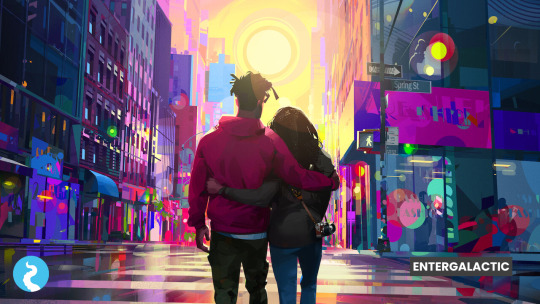
The joint Netflix-DNEG Animation production needed to create something that would showcase Cudi’s music and reflect his artistic brand, but also stand independently as a solid story with a captivating plot and realistic characters. Cudi developed Entergalactic as a story first and an album second. This enabled the love story to develop naturally, instead of being forced to weave through the album’s tracks.
youtube
Entergalactic has an eye-popping look, with strong character designs accented by striking colours and bold silhouettes. The concept portfolio shaped this, but it’s also something that can be seen in DNEG Animation’s other work including Ron’s Gone Wrong (2021) and Nimona (2023). Nimona was released on Netflix but fully animated by DNEG Animation who took over from Blue Sky Production who was originally tasked with the project before their closure.
We’ll be diving into the creation of Nimona later in this series, which was picked by Video Producer Lesley Ovington as her favourite animated film.
Get Started With Your Video
Inspired to create a unique animated video of your own? Watch the video below to get a better understanding of how Squideo can help promote your business, then get in touch with us to find out more!
youtube
#entergalactic#kid cudi#netflix animation#dneg animation#mad solar#khalabo ink society#visual album#yellow submarine#keyna barris#fletcher moules#Youtube
1 note
·
View note
Text
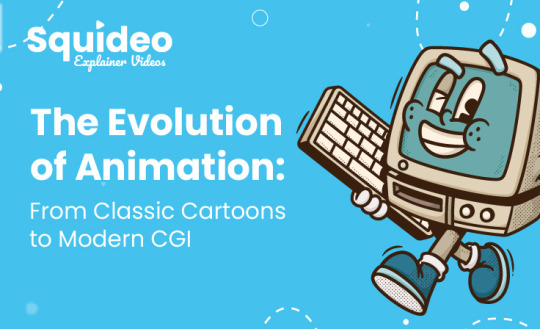
It’s hard to pin the invention of animation on a single date. Film archivists have estimated that more than 90 percent of films made before 1929 are lost forever, which makes it almost impossible to say with any certainty which first can be credited to which film.
Multiple techniques, developments and technologies were instrumental in the creation of animation as we know it today. And this progression has continued, with more variations created every decade since the 1900s. Squideo is going to dive into the evolution of animation, from its murky beginnings to the multibillion dollar industry it has become.
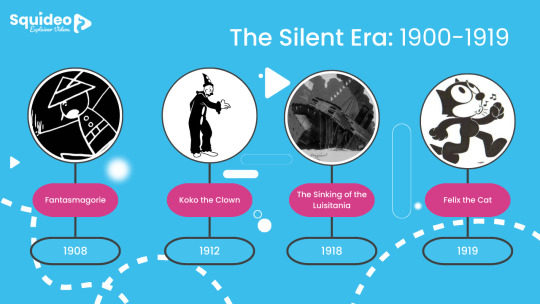
The first animated film has been credited to multiple titles, including Pauvre Pierrot (1892), The Enchanted Drawing (1900), Fantasmagorie (1908) and Gertie the Dinosaur (1912). The names of other films have been listed in newspapers from the time, but since they’ve been lost these cannot be verified.
Like live-action films of the time, these early hand-drawn animation films were silent. They would be shown in cinemas or, as in the case of Winsor McCay’s Gertie the Dinosaur, at circuses and vaudeville acts. Animators of this age were working without the later constraints of studios or censorship, and had a lot of freedom to develop new animation styles and techniques.
The realism of early animation was greatly improved by the invention of rotoscoping, first showcased in 1912’s Koko the Clown by Max Fleischer. The rotoscope technique traced motion picture footage of a human performer, and is still used to this day albeit with the use of a computer rather than manually tracing film frames.
youtube
Animation improved rapidly within these twenty years, and this is perhaps best demonstrated with The Sinking of the Lusitania (1918), by Winsor McCay. The detail from this film, which was the longest made at that time (12 minutes) and the first confirmed example of an animated documentary, was vastly improved from his first because of the introduction of cel animation. This is named after the celluloid sheets which replaced paper in the animation process, and saved animators the time of creating multiple drawings of backgrounds and stationary objects.
The realistic animation style of McCay’s film, which was widely praised, was quickly eclipsed however by a new style which swept across the American animation industry: rubber hose animation. This debuted in 1919 when Pat Sullivan and Otto Messmer created Felix the Cat.
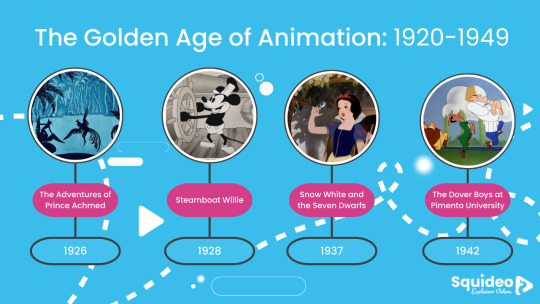
Felix the Cat was a huge draw for 1920 cinema goers, becoming a hugely popular character which featured in 89 animated cartoons between 1919 and 1925. However the creators’ reluctance to embrace sound film technology, which was debuted in 1923, saw the ultimate decline of Felix and paved the way for Disney’s eventual domination of the American animation industry.
Despite sound technology emerging early in the decade, it took time for animators to adapt it into their work. Some of the most notable animated works of the period are still silent, such as the first claymation film, Long Live the Bull (1926), and the first feature-length animated film: The Adventures of Prince Achmed (1926). Created by Lottie Reiniger, this silhouette animated film famously introduced the multiplane camera which the Walt Disney Company would later reinvent and use for their first feature-length film Snow White and the Seven Dwarfs (1937). It was Disney which arguably popularised sound in animation, with their animated short Steamboat Willie (1928).
Walt Disney was convinced that sound technology would change the future of film, and was the secret to making his new animated character – Mickey Mouse – a hit with audiences. He was right, which imbued the company with the confidence to use other animation technologies that emerged. Five years later, Disney became the first animation company to use Technicolor when it released Flowers and Trees (1932).
youtube
Disney’s style began to dominate animation, especially in America. For the smaller studios that lacked their budget and workforce, there was a desire for a different animation style that could be made faster and cheaper. Limited animation was the solution, and it ushered in a new era.
Warner Brothers Animation launched in 1933. It would soon become notable for its Looney Tunes series, but it was Merrie Melodies that brought in limited animation. This technique reduced the number of drawings required for each frame, in turn reducing the work for animators and speeding up the production process. It was ideal for television, a burgeoning medium post-WW2, which had smaller screens than cinemas. The Dover Boys at Pimento University (1942) was one of the first notable uses of the technique.
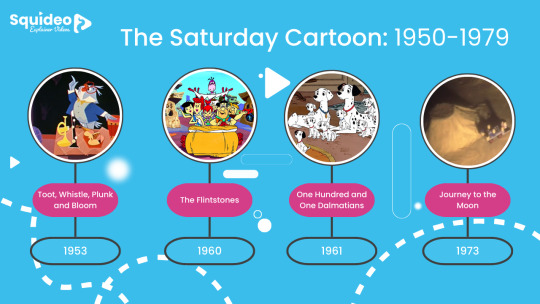
A lot of innovation during this next period occurred in television production, and it also saw the rise of amateur productions as filming equipment became more readily available to the public. Changing technology additionally created a divide between film and television animation which had differing styles and quality standards during these decades.
Disney was the first studio to use CinemaScope for its animated short Toot, Whistle, Plunk and Bloom (1953). Created by 20th Century Fox in that same year, it remained popular until its discontinue in 1967. This changed the aspect ratio of productions to accommodate wider, rectangular cinema screens. Television screens on the other hand were small and square. And at the start of the 1950s, many households still only had black and white televisions. This was perfect for limited animation, masking the reduction in animation quality. Television ownership grew rapidly through the decade, and producers started investing in cartoons.
youtube
The first animated TV series was Crusader Rabbit (1949), followed by shows more familiar to modern audiences like The Woody Woodpecker Show (1957), Captain Pugwash (1957), Yogi Bear (1958), and a reappearance from Felix the Cat (1958). The first animated show to make it to prime-time was The Flintstones, which ran from 1960 to 1966. These shows were more specifically targeted at children: referred to as cartoons rather than animated television. Created by the most successful cartoon studio of the era – Hanna-Barbera (1957-2001) – The Flintstones was followed by hits like Top Cat (1961), Wacky Races (1968) and Scooby-Doo, Where Are You? (1969).
Animated films, however, were marketed as motion pictures. By the end of the decade, animation studios had started to use xerography animation – first trialled in Sleeping Beauty (1959), then fully used in One Hundred and One Dalmatians (1961). Disney’s Ub Iwerks had adapted the Xerox process, first introduced during WW2, to work on film. This copying technique allowed animator drawings to be printed directly onto cels, massively speeding up the production process. This technique was used throughout the 1960s and 70s and other animation studios adopted the technology.
youtube
New technology also became available to the general public. The commercially successful Super 8 camera launched in 1965, and amateur animators were able to record their own cartoons. This inspired new animation styles, such as brickfilming. Journey to the Moon (1973) was the first recorded of its kind, and paved the way for future animated films like The Lego Movie (2014).
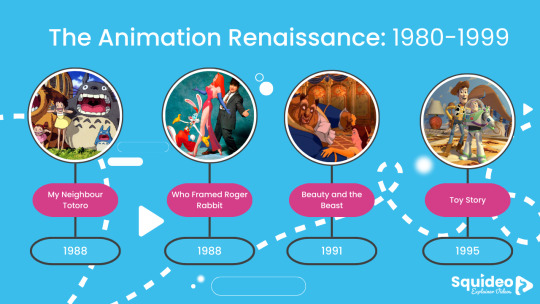
At the start of the 1980s, ‘Saturday morning cartoons’ were flourishing while animated motion pictures were in decline. This was perhaps best exemplified by Disney, who launched Disney Television Animation (1984), while the Walt Disney Animation Studios had its budget slashed. One of its most popular 1980s films, Who Framed Roger Rabbit (1988), was created by an animation department which had just been sent into exile from the main studio lot.
Likewise, the other Big Five production companies started focusing on television animation. Paramount Studios created Nickelodeon (1977) and Warner Brothers Cartoons shifted to create television content. This unit would later become Cartoon Network Studios (1994). The biggest television cartoon to emerge from this period is The Simpsons, which first aired in 1987 on The Tracey Ullman Show, and is one of Fox Broadcasting Company’s biggest assets.
This did leave space for overseas animation companies, most notably the Japanese Studio Ghibli, to find the spotlight with English-speaking audiences. Castle in the Sky (1986) and My Neighbour Totoro (1988) were both critically acclaimed. Likewise, Aardman Animation – the British claymation studio – rose to prominence with its work on the Peter Gabriel Sledgehammer (1986) music video which paved the way for its Creature Comforts and Wallace and Gromit series in the 1990s. Universal Pictures also launched DreamWork Pictures in 1994, releasing its first film Antz in 1998, and would become a big player in the 2000s.
youtube
Arguably the most successful studio to emerge was a small computer division originally created by Lucasfilm in 1979. Pixar pioneered 3D computer animation which they first publicly debuted in The Adventures of André & Wally B (1984). They would go on to make the first 3D computer animation feature film, Toy Story (1995), with Disney – although they were beaten in television by Canadian studio Mainframe Entertainment’s ReBoot (1994).
Disney was already developing digital production techniques such as its Animation Photo Transfer (APT) process was first used in Black Cauldron (1985). Their partnership with Pixar, formalised in 1991, massively improved this digitalisation; most notably with CAPS. First used in The Rescuers Down Under (1990), the Computer Animation Production System provided a host of new digital tools to animators, and kickstarted the Disney Renaissance.
This produced massive hits, not just for Disney but also breaking global box office records. The success of their films, especially The Lion King (1994) prompted their rivals to revive their own animated feature film projects. Other animated feature hits of the 1990s included Space Jam (1996), Anastasia (1997), Antz (1998), The Rugrats Movie (1998) and The Iron Giant (1999).
youtube
The highest-grossing hits of the 1990s belonged to Disney and Pixar with the top five films being The Lion King (1994), Aladdin (1992), Toy Story 2 (1999), Tarzan (1999) and Beauty and the Beast (1991). The latter film also became the first animated film to be nominated for the Academy Award for Best Picture.
Alongside 3D computer animation, CGI (computer-generated imagery) was growing in popularity for live-action films. First appearing in Westworld (1973), it opened the door for creators. In 1999, the latest CGI trend – motion capture animation – was used to add the first fully animated character into a live-action picture. While Jar Jar Binks wasn’t the biggest hit, Star Wars: The Phantom Menace (1999) proved to be a turning point for computer animation as the new century began.
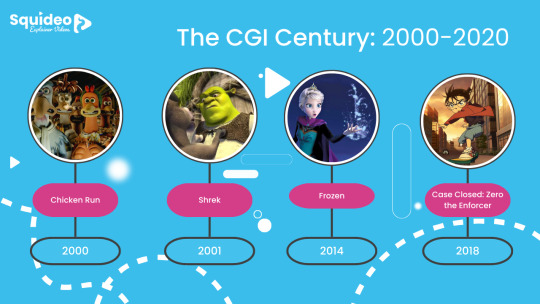
CGI and 3D computer animation has permanently changed animation. Few films over the past twenty years were created using the traditional hand-drawn 2D animation process, although they still proved popular with audiences. This included the French film Les Triplettes de Bellville (2003), Spain’s Klaus (2019), Japan’s Ponyo (2008) and America’s The Simpsons Movie (2007). All of these films still use digital animation tools to streamline production and minimise costs.
What these changes mean, however, is that animation is no longer ruled by the largest corporations with the largest animation departments. Small teams of animators can create quality feature films using the available technology, and this has propelled the growth of small production studios. The introduction of streaming platforms has also widened the viewership for international animation.
Japanese animation, particularly in the anime style, has benefited from this. While Japanese studios gained a foothold with western audiences in the late 1980s, it has recently catapulted in popularity. Netflix reported that 50 percent more households around the world watched at least one anime title during the first nine months of 2020 compared to the whole of 2019. Studio Ghibli remains the most successful export, continuing its success with Spirited Away (2001), Howl’s Moving Castle (2004) and The Tale of Princess Kaguya (2013) to name a few. More studios are joining their ranks, such as the record-breaking MAPPA, WIT Studio, Madhouse and CoMix Wave Films.
youtube
Other non-American studios that are benefiting from the decentralisation of the animation industry include Aardman Animation, Les Armateurs, BreakThru Films, The SPA Studios and Cartoon Saloon. American animators have also broken away from the studio system. LAIKA was created following the success of A Nightmare Before Christmas (1993), this studio has since released Coraline (2009) which is America’s highest-grossing stop-motion film.
Many of these films are still distributed through large American companies or made in partnership with them. Illumination Studios, the makers of Despicable Me (2010) and The Grinch (2018), was incorporated into a Universal Pictures division almost as soon as it was founded. And Aardman Animation’s stop-motion feature film Chicken Run (2000) was made with DreamWorks Animation, a unit of Universal Pictures.
Since its first film in 1998, DreamWorks has gone on to create two of the most profitable animated franchises: Shrek and Madagascar. Shrek (2001) helped define the future of DreamWorks and its aim to become the antithesis of Disney – an interesting goal considering it was co-founded by a former Disney chairman, Jeffrey Katzenberg, and Disney collaborator, Stephen Spielberg. Shrek modelled its characters after their celebrity voiceover artists; it ditched original scoring for pop songs; and it leant into juvenile humour.
youtube
Disney – which purchased Pixar Animation Studios in 2006 – continued to make 2D style animation at the beginning of the 2000s. With the rising success of other 3D animation features like Toy Story and Shrek however, this was phased out. Disney’s last 2D animated feature film to date was Winnie-the-Pooh (2011), and its last 2D Disney Princess was Tiana in Princess and the Frog (2009).
Their biggest hits were Pixar productions – Finding Nemo (2003), Up (2009), The Incredibles (2004), Ratatouille (2007), Monsters, Inc. (2001), WALL-E (2008) and Cars (2006) – until Frozen (2013) returned them to the top. The top three highest-grossing animated films of the 2010s belonged to Disney.
Disney hasn’t ruled out a return to 2D animated features and, for its 100th anniversary celebrations, has created new 2D animated shorts which resurrect original characters like Oswald the Lucky Rabbit.
As one of the oldest animation studios in existence, it feels natural to look to Disney for an indication where the industry is heading in the 2020s. But as the past thirty years have proved, the industry has become a more even playing field where anyone can succeed.
Work With Us
Ready to create an animated video of your own? Watch the video below to get a better understanding of how Squideo can help promote your business, then get in touch with us to find out more!
youtube
#animation history#lost films#fantasmagorie#gertie the dinosaur#rotoscope#koko the clown#the sinking of the lusitania#cel animation#rubber hose#rubber hose animation#felix the cat#claymation#long live the bull#the adventures of prince achmed#multiplane camera#snow white and the seven dwarfs#steamboat willie#mickey mouse#technicolor#flowers and trees#merrie melodies#limited animation#cinemascope#the flintstones#xerography#super 8 camera#brickfilm#who framed roger rabbit#studio ghibli#aardman animations
1 note
·
View note
Text
Happy Halloween! 🧟 Are you enjoying the spookiest day of the year? 🧟♂️ Our latest short has gotten into the spirit, we hope you enjoy it! 🧟♀️
#2d animation#small business on tumblr#animation#zombie#happy halloweeeeeeen#halloween#halloween art
0 notes
Text
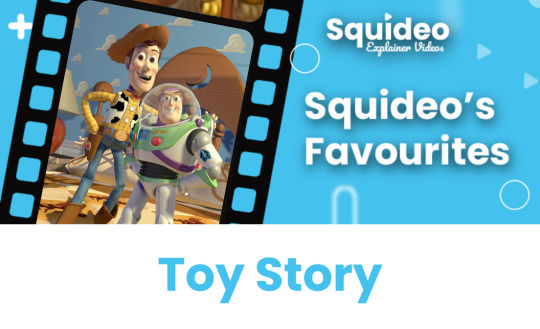
Squideo’s Favourites: Toy Story
Pixar Animation Studios arrived with a bang when its first feature-length film, Toy Story, was released in 1995. What would follow was a franchise beloved by children, spawning multiple spin-offs, theme park rides, video games and merchandise. Nominated for 4 Academy Awards, Toy Story is now considered one of the best animated films of all time.
Toy Story is credited with opening up the world of 3D computer animated films, which still rules the industry to this day. With the sponsorship of Disney, Pixar used this technology to create a film that visually stood apart from everything else at the box office and helped complete Pixar’s journey from a small computer division at Lucasfilm to an award-winning studio that has produced some of the best animated films of the past thirty years.
We’re diving into the production behind this animated film, exploring the style and techniques which came together to create this compelling story. In the meantime, if you have an idea for an animated video of your own get in touch with the Squideo team.
Creating a Story
To any fan of animation, Buzz Lightyear and Woody are well-known characters. Yet without Tinny, who reached nowhere near as much fame, they may never have graced our screens.
Pixar Animation Studios had produced a number of animated shorts before it ventured into feature length production, starting with Luxo Jr. (which introduced Pixar’s mascot). Red’s Dream followed, but it was Tin Toy that caught Disney’s attention. Financed by Steve Jobs, Tin Toy was a five-minute short created and directed by John Lasseter. Seen through the perspective of a toy running away from a destructive infant, Tin Toy laid down the groundwork for Toy Story – another Lasseter creation.
Disney had only recently allowed films to be made outside its own production company, starting with Tim Burton’s Nightmare Before Christmas (1993).
In a 2011 interview with Entertainment Weekly, [John Lasseter] said: "Disney kept trying to hire me back after each of the short films I had made. I kept saying, 'Let me make a film for you up here.” They always said, 'No, a Disney animated film will always be made at Disney.' They had no interest in doing an outside project." Lasseter continued: "What changed their mind was Tim Burton. Tim and I went to college together, and he had developed a feature idea called 'The Nightmare Before Christmas.' He went on to become a successful live-action director and was trying to buy 'Nightmare' back from Disney. And they said, 'Why don’t you just make it for us?' That opened the door for Disney to think of these niche animated films that could be done. They said, 'Okay, we’re willing to talk with you. We’ve got puppet animation going [with Tim Burton] and now we’ll be willing to develop the computer animation.' They said to come back when we had an idea. So we started thinking…" John Lasseter
youtube
3D computer animation developed alongside CGI in the 1970s, but a fully created computer animation television show or film didn’t debut until the 1990s. Yet animation companies, including Disney, had already played with the new technology before then. The Great Mouse Detective (1988) was the first Disney film to extensively use CGI: creating a two-minute sequence which was heavily promoted in the film’s marketing.
Their CGI was developed in cooperation with Pixar, the two companies coming together to make CAPS, the Computer Animation Production System which was relied upon heavily during the Disney Renaissance.
The technology was new, which put giant animation studios at a disadvantage. Their artists were trained in 2D animation techniques, leaving a void for computer companies who had the expertise to utilise this new technology.

Animation Style
The use of this new technology resulted in a film that looked vastly different from everything that predated it. Not only did 3D computer animation provide greater realism, but the independence of these early animators also meant they were not constrained by an existing “style” favoured by a company.
To this day, animated characters start life at Disney as 2D concept drawings which influences the style once it is converted to 3D. Pixar on the other hand is at home in that format, and their animators create greater complexities and detailed textures in their work.
“There are differences between Pixar and Disney. If you reduced Pixar to a phrase it would be: ‘Wouldn’t it be cool if?’ Like if a kid was looking at their toy: What if the toy could talk? All their films are like this. If you reduced the Disney films it would be: ‘Once upon a time…’.” Glen Keane
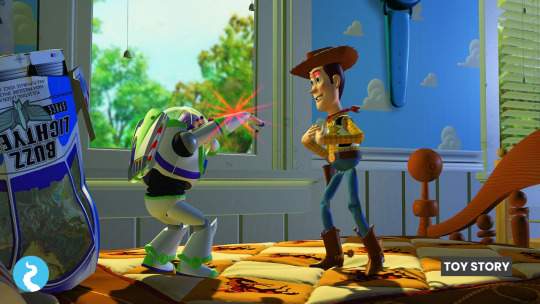
The filmmakers designed the minor characters using memories of their childhood toys, but the two leads were a different story. Woody and Buzz Lightyear went through several redesigns, along with the addition and removal of multiple human characters. Thankfully, Disney brought Joss Whedon onboard as a co-writer after reviewing the initial drafts. Now best known for directing and writing Marvel’s The Avengers (2012), Firefly (2002) and Buffy the Vampire Slayer (1997-2003), Toy Story was his first hit for which Whedon shared an Academy Award for Best Original Screenplay.
Because 3D computer animation was so new, even the lead actors didn’t know what the film would look like. Tom Hanks, who voiced Woody, said: “The shading and the light and its starting to look crisp and clean it looks surreal and real, it had a really neat 3-D quality to it without that fuzzy eyeball stuff.”
While Tim Allen, who voiced Buzz Lightyear, said: “When I first saw it I thought, 'I don't know if kids are gonna buy this, adults especially not, it's too high tech, it looks too much like a video game. And they got the second generation, third generation, it started looking slicker and slicker and then they finally finished with a shot of the soldiers going 'one, two, three, let's go!' and they went down the rope, wow! What a view!”
youtube
Pixar’s software was key to the animation of Toy Story. From RenderMan to Menv, the latter of which has since been replaced at Pixar by Presto, it took over 400 computer models to make the film. And it was worth every second of development. Toy Story showed the world that – not only was Pixar the new kid on the animation block – but that they also held the key to the future of animated film.
Get Started With Your Video
Inspired to create a unique animated video of your own? Watch the video below to get a better understanding of how Squideo can help promote your business, then get in touch with us to find out more!
youtube
#toy story#pixar animation studios#pixar#disney#walt disney animation studios#3d computer animation#3d animation#computer animation#buzz lightyear#woody#tin toy#tinny#steve jobs#john lasseter#tim burton#nightmare before christmas#CAPS#computer animation production system#glen keane#joss whedon#tom hanks#tim allen#renderman#menv#presto#youtube#2d animation#animation#small business on tumblr#small business
3 notes
·
View notes
Text
Autumn leaves a smile on our faces at Squideo! Here's this week's animated short 🎃
#scarecrow#fall aesthetic#fall autumn#autumn aesthetic#pumpkin patch#animated short#2d animation#small business on tumblr#animation
1 note
·
View note
Text
Looking for some Wednesday motivation? Check out this week's animated lofi short!
0 notes
Text
565 notes
·
View notes
Text
We're dropping in for a close encounter of the Squideo kind! A big kudos to the team who worked together to make this reel 👽🛸
2 notes
·
View notes
Text

Squideo’s Favourites: Gertie the Dinosaur
Released in 1914, this short film was created by Winsor McCay – a vaudeville actor who started producing cartoons in 1911. As one of McCay’s best preserved works, Gertie the Dinosaur has gone down in animation history for its innovative techniques and for a time was counted as the earliest animated film until other records were found.
Despite its short running time of twelve minutes, the piece has inspired countless successive animators from Walt Disney to Max Fleischer. It was chosen for this series by Creative Director Hannah Bales who credits Gertie the Dinosaur with introducing animation techniques still used to this day.
We’re diving into the production behind this animated film, exploring the style and techniques which came together to create this compelling story.
Creating a Story
Winsor McCay started working as an artist before becoming an illustrator and cartoonist for numerous Chicagoan newspapers. In 1911, McCay came to work at the New York American, owned by the infamous William Randolph Hurst. That same year, McCay self-financed and released his first animated film Little Nemo in Slumberland.
It was released in cinemas and McCay used the piece in his vaudeville act – a profession he maintained alongside his newspaper career for several years until Hurst convinced him to prioritise his illustrations. Little Nemo in Slumberland used characters McCay had created for a comic strip at the New York Herald, his former employer, a series McCay used to develop his use of colour and fine hatching. Little Nemo was already popular with audiences, first debuting in 1905 and receiving a stage adaptation in 1907.
Audiences were entranced by the 1911 short film, which became popular enough for McCay to colourise the frames. Sadly, like many of McCay’s early works – including How a Mosquito Operates (1912), Flip’s Circus (1918) and The Centaurs (1921) – only fragments of the film have survived. Which led to the later Gertie the Dinosaur (1914) becoming McCay’s signature film.
youtube
As Gertie the Dinosaur was created for McCay’s vaudeville act, the film is timed to create the illusion that McCay – standing beside the screen – is controlling Gertie. To end the film, McCay walked toward the screen and was replaced with an animated equivalent that Gertie carried away. This use of animation showed audiences what potential this developing medium had, and inspired a wave of new animators to follow in McCay’s footsteps.
William Fox, founder of the Fox Film Corporation, paid McCay to extend the film to include a live-action introduction so Gertie the Dinosaur could be shown in cinemas without McCay’s presence. Despite this success, McCay’s own employer William Randolph Hurst banned their newspaper from mentioning Gertie the Dinosaur. Comic strips were very popular in newspapers and, as one of his most popular illustrators whom he had bought away from the New York Herald, Hurst wanted McCay’s attention at the New York American rather than his own side-projects.

McCay would make ten films in total, an impressive achievement considering he almost entirely worked alone. His post-war release, The Sinking of the Lusitania, in 1917 garnered him additional critical acclaim and cemented McCay as an animation pioneer.
“McCay distinguished his work from that of his contemporaries in the field by the sophistication of his elaborate graphics, the fluid movement of his characters, the attempts to inject personality traits into those characters, and the use of strong narrative continuity.” John Canemaker
In an episode of Walt Disney’s Disneyland in 1955, Disney paid homage to Winsor McCay and Gertie the Dinosaur – inviting McCay’s son Robert to act as a consultant. The influence of Gertie the Dinosaur still lives on at Disney, spanning from its first reference in 1940’s Fantasia, to their animatronic dinosaurs for New York’s World Fair in 1964, and now Gertie’s ice cream stand opened in Disney’s Hollywood Studios at Walt Disney World in 1989.
Animation Style
Created from over 10,000 drawings, Gertie the Dinosaur was a tremendous undertaking almost entirely created by Winsor McCay with his neighbour John A. Fitzsimmons acting as an assistant. Since the film would form part of his vaudeville act, McCay needed a showstopper – and he wanted to indisputably show the world that his animation skills were unrivalled.
When his 1912 film, How a Mosquito Operates, had debuted some audience members thought the mosquito was operated on wires. That same year, McCay announced his intention to create a film about dinosaurs.
Despite the short time frame between both films, Gertie the Dinosaur shows significant progress which left audiences with no doubt that they were watching animation. More details were added to the characters and, importantly, backgrounds were added to the frames.
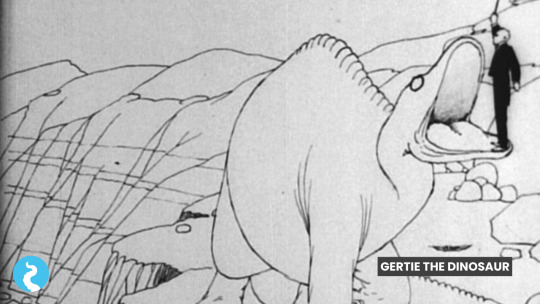
McCay used fine hatching to add shadows and depth to Gertie’s movement. He established the use of now standard animation techniques, including “key drawings, effective registration of images to prevent “jitters”, and the concept of “cycling” action that reused drawings.”
Using a constructed dinosaur skeleton on display at the New York Museum of History for reference, McCay worked in painstaking detail to make Gertie as realistic as possible. It worked. According to McCay:
“When the great dinosaur first came into the picture, the audience said it was a papier-mâché animal with men inside of it and with a scenic background. As the production progressed they noticed that the leaves on the trees were blowing in the breeze, and that there were rippling waves on the surface of the water, and when the elephant was thrown into the lake the water was seen to splash. This convinced them that they were seeing something new – that the presentation was actually from a set of drawings.” Winsor McCay
McCay’s work continues to have an influence over modern animators, and since 1972 the Winsor McCay Award has been given in recognition of individuals whose work shows outstanding contributions to excellence in animation. Famous recipients include Bill Hanna, Joseph Barbera, Mel Blanc, Otto Messmer, Roy E. Disney, Tim Burton, John Lasseter, Nick Park, Brad Bird and Matt Groening.
Get Started With Your Video
Inspired to create a unique animated video of your own? Watch the video below to get a better understanding of how Squideo can help promote your business, then get in touch with us to find out more!
youtube
#gertie the dinosaur#winsor mccay#animation history#2d animation#video production#youtube#animation#small business on tumblr#Youtube
4 notes
·
View notes
Text

Behind the Scenes: The Top Animated Video Production Fails and Bloopers
Everyone makes mistakes, and for our small Squideo squad it’s reassuring to know they even happen at the largest animation companies. From DreamWorks to Disney, we’re breaking down the ten most obvious on-screen fails and bloopers in animated films.
Read on to find out who made the cut and let us know if we’ve missed something!
01. The Lion King
The protagonist of this 1994 Walt Disney Studios classic, Simba, grows from a cub to an adult during the course of The Lion King. Changes to his appearance were expected, but there were some minor details that clearly slipped by the producers. Sometimes Simba has three whiskers on either side, sometimes four, occasionally five, and one time six.

The film has some other continuity errors, but this one is definitely the cutest to look at.
02. Shrek
The first film to win the Academy Award for Best Animated Film, the Shrek franchise started in 2001 and helped DreamWorks Animation became a serious rival to Pixar and the Walt Disney Animation Studio. Spawning three sequels and two spin-off films, the most recent of which came out in 2022, there’s no sign of the Shrek franchise slowing down either.

Like all studios who have a vast body of work behind them, there’s bound to be the odd blooper and Shrek is no exception. In one scene, Shrek creates a warning sign on a piece of wood which the animators failed to flip when looking at it from behind.
03. Toy Story 2
The sequel to the wildly popular Toy Story came out in 1999 and created more heartbreak when it separated Woody from his beloved owner Andy. Taken in by a toy repairer who sees value in Woody, the name of his owner is erased from existence in a massively satisfying montage which has since been adopted by the ASMR community.

With a sweep of a brush, Andy’s name is painted over. Woody soon rubs away the paint, however the name is suddenly upside down with the A next to the heel instead of at the toe.
04. Beauty and the Beast
No one fights like Gaston, douses light like Gaston, or moves furniture as fast as Gaston. During this musical number in 1991’s Beauty and the Beast, a number of hunting trophies are littered about to show Gaston’s skill – and cruelty. The most prominent is a vast bear rug, which teleports from a cosy spot by the fire to the feet of Gaston’s throne in a matter of moments.

It's a pity Gaston fell to his death (in classic Disney villain fashion), the Prince could have hired him as a decorator.
05. Spirited Away
Studio Ghibli’s 2001 classic Spirited Away became the first hand-drawn and non-English speaking animated film to win the Academy Award for Best Animated Feature. This is a technically beautiful film and a Japanese classic, despite the occasional continuity error. When meeting No-Face, Chihiro is surrounded by ropes and brooms – some of which disappear only to reappear in a different frame.

It's such a beautiful sequence, however, that viewers are unlikely to catch that, or the colour-changing cushions, until they’re on their fifth or so rewatch.
06. Cinderella
While Disney’s second princess is most recognised in her ballgown, this 1950 adaptation of the fairy tale also includes a beautiful wedding dress. A beautiful wedding dress with long sleeves. A beautiful wedding dress without a choker necklace. The happy couple leave the chapel, with Cinderella losing one of her shoes in the process (typical).

A quick change must have happened, because only seconds after they board the carriage Cinderella is back in her ballgown – capped sleeves and choker necklace included – with only the veil and tiara remaining in place.
07. Sleeping Beauty
While we’re on Disney Princesses, Cinderella’s successor was Sleeping Beauty which came out in 1959. Influenced by European pre-Renaissance art, Disney wanted their newest fairy tale to look visually different from Cinderella. A lot of detail went into creating this film, which went into development in 1950.

Unfortunately the detail on Aurora’s tiara varies, typically appearing as a plain gold band except in the moments after her collapse from the curse when it is suddenly adorned with gemstones.
08. Monsters, Inc.
If you don’t know what a Code 2319 is, you’ve clearly never seen Pixar’s 2001 masterpiece Monsters, Inc.. Professional scarer, George Sanderson visits an assignment and comes back with more than memories. Coming into contact with a child’s sock triggers a massive alert and protagonists Sulley and Mike Wazowki watch as he is decontaminated – and de-furred.

Considering their aversion to humans, it seems unlikely George would have touched the sock so it must have been an animating error that led to it pointing in opposite directions between shots.
09. The Lego Batman Movie
Running Wayne Manor must keep Alfred busy, but it seems unlikely he’s moving around the portraits every other second. Unless the culprit is the ghost of Batman’s parents, it seems likely then that this blink-and-you’ll-miss-it error was the fault of the animators working on The Lego Batman Movie. When talking to a portrait of his dead parents, the pictures surrounding it change.

It was still a touching scene, and the 2017 film has an impressive 90% rating on Rotten Tomatoes.
10. Aladdin
The animated version of the classic tale Aladdin features Rajah, the devoted and protective pet tiger of Princess Jasmine. Jasmine rebuffs her father, the Sultan’s, attempts to arrange her marriage and it seems that Rajah is on her side. He attacks Prince Achmed, presenting Jasmine with a shred from his underwear as a well-received gift.

When Prince Achmed storms out of the palace however, his trousers are ripped but not his underwear. A funny scene, nevertheless, and suitable for a PG-rated film.
Work With Us
Ready to create an animated video of your own? Watch the video below to get a better understanding of how Squideo can help promote your business, then get in touch with us to find out more!
youtube
#2d animation#animation#animation bloopers#disney#pixar#dreamworks#the lion king#shrek#toy story#toy story 2#beauty and the beast#gaston#spirited away#cinderella#studio ghibli#sleeping beauty#aurora#monsters inc#lego batman movie#lego batman#aladdin#disney animation#Youtube
6 notes
·
View notes
Text
Squideo is hopping into Wednesday with this short. It's un-frog-ettable 🐸
5 notes
·
View notes
Text
The Coolest Animated Characters of All Time: Icons That Stole Our Hearts
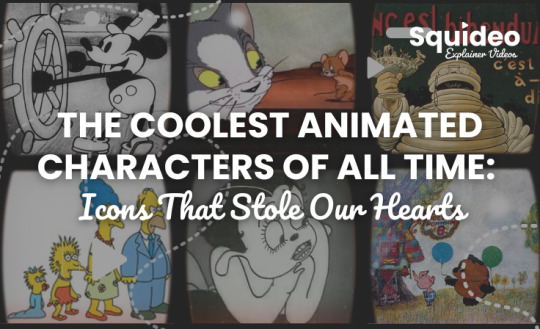
Animation offers a vast variety of options for character design, each created to attract a particular demographic. Not every character becomes an icon, however, which is why Squideo is breaking down the animation character designs of ten of the coolest animated characters of all time.
01. Mickey Mouse
The icon of the Walt Disney Company, Mickey Mouse is arguably the most recognisable character in the world. Created by Walt Disney and Ub Iwerks in 1928, Mickey Mouse is one of the oldest entries on this list (but not the record holder) and helped make Disney the company it is today. As is often the case for successful creations, there is some dispute how Mickey was created; but we’re glad to have him.

Mickey Mouse set the style for all future Disney animation designs. The rounded character, use of bold colours and a distinctive colour palette for each character; it all started with Mickey. Disney has its own unique animation style, crafted over its 100 year lifespan. The animation style has changed over the years with the incorporation of new technology, especially 3D computer animation, but remains distinguishable from other animation companies.
02. Winnie-the-Pooh
First featured on screen in 1966, the character of Winnie-the-Pooh was created in 1925 by British author A. A. Milne and illustrated by E. H. Shepard. The rights are held by Disney, yet other adaptations have been made. Perhaps the antithesis to the Disney version is the Soviet Union’s version of the famous bear, released in 1969 and followed by two additional films, which removes Christopher Robin but adds a narrator.

With the exception of the 1925 and 1969 versions of Winnie-the-Pooh, the character design remained consistent in the Disney productions which helped this Winnie-the-Pooh become the most identifiable version of the character. In that classic Disney style, Winnie-the-Pooh is soft and cuddly, and easily spotted with his amber and red colour palette.
03. The Simpsons
Sticking with yellow-hued characters, it’s time to look at one of Earth’s most popular families. First appearing in 1987 as a short in The Tracey Ullman Show, The Simpsons went on to get their own franchise in 1989 that is running to this day. It’s the longest-running American sitcom and animated series with 34 seasons and 750 episodes (as of August 2023).

Beyond the prominence of the colour yellow, The Simpsons are recognisable for their geometric appearance. Bart, Lisa and Maggie’s spiky hair, Homer’s chevron hairline and Marge’s rectangular dress. The design is easy to reproduce and remains recognisable even if the style changes. The Simpsons have hosted many guest artists for the couch gag, from Guillermo del Torro to Sylvain Chomet, yet no one would mistake what they were watching for any other animated show.
04. Bibendum
Bibendum, known as the Michelin Tyre Man in the English-speaking world, is the oldest entry on the list. First created for this French company in 1894, this character has become an icon the world over and remains one of the oldest trademarks still in use. Its popularity has been referenced in books, film, television and songs. The character even starred in a 2009 animated short film, Logorama.

The character has changed over the years to reflect the times, but every version remains identifiable as the Michelin Tyre Man. Despite tyres turning black in the 1910s, the character has retained the whiteness of the earliest tyres in production. After 120 years, it would be hard to change the essential makeup of this character without destroying the Michelin brand.
05. Mulan
The eighth addition to the Disney Princess line-up, and the first who was not a real princess, Mulan hit the screens in 1998. This animated character reinvented the formula of a Disney Princess film, by making Mulan into a hero who saves herself, her family and her country. The romance is relegated to a subplot, and the film doesn’t end with a wedding.

Despite Mulan only having two feature films to her name (1998, 2004), the character has appeared in multiple Disney shows and videos games, most famously appearing in 2016 Wreck It Ralph with the other Disney Princesses. Her tenure as a Disney Princess hasn’t gone without controversy, however. A redesign in 2013 prompted a public backlash as the character’s skin was lightened, causing a swift reversal by Disney.
06. Scooby-Doo
These mystery solvers have been on television since 1969, branching out into films (animated and live-action), video games and comics. The core gang have stayed in place with the titular Scooby-Doo joined by his friends Shaggy, Velma, Daphne and Fred. Some additions have been made to the original Hanna Barbera line-up, such as the divisive Scrappy-Doo.

Like the other oldies on the list, the Scooby-Doo characters have seen significant redesign over the years. From making them children in A Pup Named Scooby-Doo (1988) to giving the human characters tiny eyes in Scooby-Doo! Mystery Incorporated (2010), but the biggest change came with Velma (2023) which sought to diversify the originally all-white cast.
07. Totoro
Despite being the subject of only one feature-length film, the character Totoro from My Neighbour Totoro (1988) has become a cultural icon in Japan. Brought back in ani-manga books, a novel and – most recently – a stage adaptation, Totoro has fame outside of Japan too. In fact, its popularity led to a cameo of Totoro in Toy Story 3 (2010).

Created by Studio Ghibli, Totoro has been adapted as the production company’s mascot much like Mickey Mouse has been at Disney. Using hand drawn animation, bright colours and individually coloured frames, the rich visual style is a sharp contrast to the Western examples featured in this list.
08. Tom and Jerry
Created by the renowned William Hanna and Joseph Barbera duo 17 years before they formed their own company, Tom (originally called Jasper) and Jerry were originally the product of MGM when these characters first debuted in 1940. The journey has continued in the hands of numerous producers and three studios, making fans with their slapstick comedy for over 80 years.

Tom’s angular ears and fur are set against Jerry’s rounded character, making them opposites in both personality and appearance. While the animation style has shifted slightly over various incarnations, the original 1940 characters are still identifiable in 2021’s Tom and Jerry in New York. The only real difference is the lightening of both characters’ fur and the addition of Tom’s sinisterly evil eyebrows.
09. Betty Boop
Made by Fleischer Studios in 1930, Betty Boop’s appearances in television and film hasn’t increased much since the decade of her creation. In spite of her limited filmography, Betty Boop has become one of the most iconic animated characters of all time – replicated in merchandise, comic book films and two films in the 1980s.

Betty Boop is a personification of the 1920s and flapper style. At first, the character was meant to be an anthropomorphic French poodle but Betty Boop was soon modelled after singer Helen Kane instead from who the classic catchphrase came: “Boop Oop a Doop.” Heavily censored by the Hays Code in 1934, Beety Boop’s appearance drastically changed – but it was that early incarnation that has lasted into modern times.
10. The Smurfs
Created by the Belgian comic artist Peyo in 1958 under the name Les Schtroumpfs, The Smurfs is one of the highest-grossing media franchises of all time. Popularised with English-speaking audiences when The Smurfs’ TV series launched in 1981, these iconic blue characters with their distinctive white hats (called ‘Phrygian caps’) quickly entered the mainstream.

These characters are so popular in Belgium that in 2005, UNICEF used The Smurfs to create an advert for their fundraising campaign for Burundi and the Democratic Republic of the Congo – both former Belgian colonies. They’ve since been reimagined in the 2010s using 3D computer animation, bringing The Smurfs to another generation of viewers.
Work With Us
Ready to create a cool animated character of your own? Watch the video below to get a better understanding of how Squideo can help promote your business, then get in touch with us to find out more!
youtube
#animated characters#disney animation studios#mickey mouse#walt disney#ub iwerks#winnie the pooh#aa milne#eh shephard#christopher robin#the simpsons#the tracey ullman show#matt groening#homer simpson#marge simpson#bart simpson#lisa simpson#maggie simpson#guillermo del toro#sylvain chomet#the simpsons couch gag#bibendum#michelin tyre man#logorama#mulan#disney mulan#wreck it ralph#scooby doo#hanna barbera#a pup named scooby doo#scooby doo mystery incorporated
4 notes
·
View notes
Text
Squid + Video = Squideo 🦑🎥 Where the squid came in, you'll have to ask our founders. But it's our mascot now!
#branding inspiration#pronunciation#team effort#men in black#brain scan#austin powers in goldmember#austin powers#the it crowd#the meg#the big lebowski#intolerable cruelty#gilligan's island#scrooged#meet the parents#it came from beneath the sea
5 notes
·
View notes